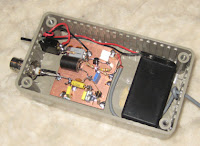Yesterday I ran my 5W 8.7608kHz beacon into the earth electrode antenna on a quasi-continuous basis with transmissions of 30-60 minutes interspersed with 30-60 minute breaks. The tests lasted from 0900-2200z. Several stations between 25-70km were looking for my signals and Paul Nicholson up in Yorkshire has still to analyse his recorded files. So far, no station has detected any sign of the signal, which was not surprising considering the
radiated ERP would have been in the pW level. I was hoping that a few stations 10-20km from JO02dg might have been looking as these would have had some chance of copying something. So, an unsuccessful test this time.
Paul Nicholson (Todmorden) advises me to use a GPS locked source so that the TX frequency is known with great precision. Then he, and others, can look for statistically significant weak signals at precisely the times and frequency of transmission. My HF crystal and divider source would not have been sufficiently stable to allow this sort of "digging in the noise" over any great time period. For QRSS3, the current stability is fine. For the record, these were my transmission times: 0840-1000z, 1029-1229z, 1330-1500z,1531-1600z, 1630-1800z, 1830-1900z,1930-2207z on 15.12.10.











